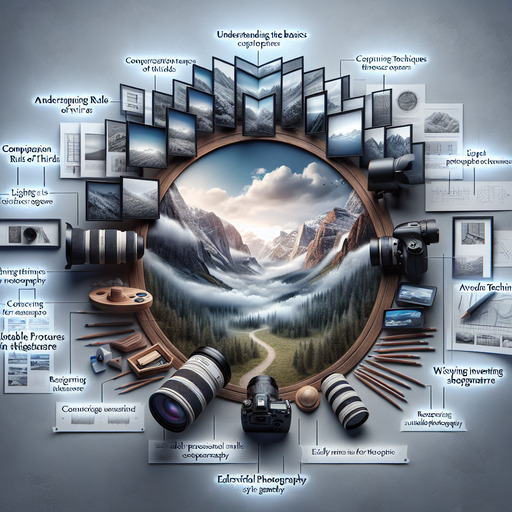
-
Table of Contents
- Mastering Photography: Essential Tips and Techniques for Every Photographer
- Understanding the Basics: Photography Techniques
- Composition: The Rule of Thirds
- Lighting: The Key to Professional Photography
- Advanced Techniques: Elevating Your Photography
- Portrait Photography: Capturing Emotion
- Landscape Photography: Creating Depth
- Editing: Enhancing Your Images
- Photography Editing Software
- Photography Gear: Investing Wisely
- Essential Photography Equipment
- Conclusion: Elevate Your Photography Skills
- Questions and Answers
Mastering Photography: Essential Tips and Techniques for Every Photographer
Photography is more than just capturing moments; it’s about telling stories, evoking emotions, and creating art. Whether you’re a budding photographer or a seasoned professional, understanding the nuances of photography can elevate your work to new heights. In this guide, we’ll explore essential photography tips, techniques, and insights to help you refine your craft and produce stunning images.
Understanding the Basics: Photography Techniques
Before diving into advanced techniques, it’s crucial to master the basics. These foundational skills will serve as the building blocks for your photography journey.
Composition: The Rule of Thirds
One of the most fundamental photography techniques is the rule of thirds. Imagine your image divided into nine equal segments by two vertical and two horizontal lines. Positioning your subject along these lines or at their intersections can create more balanced and engaging photos.
- Example: In landscape photography, place the horizon along the top or bottom third of the frame.
- Case Study: Ansel Adams often used the rule of thirds to create dynamic compositions in his iconic black-and-white landscapes.
Lighting: The Key to Professional Photography
Lighting can make or break a photograph. Understanding how to manipulate light will significantly impact the quality of your images.
- Natural Light: Utilize the golden hour—shortly after sunrise or before sunset—for soft, warm lighting.
- Artificial Light: Experiment with different photography lighting setups, such as softboxes or reflectors, to achieve desired effects.
Advanced Techniques: Elevating Your Photography
Once you’ve mastered the basics, it’s time to explore advanced techniques that can set your work apart.
Portrait Photography: Capturing Emotion
Portrait photography is about more than just capturing a person’s likeness; it’s about conveying their personality and emotions.
- Tip: Engage with your subject to make them comfortable, resulting in more natural expressions.
- Example: Renowned portrait photographer Annie Leibovitz often spends time talking to her subjects before shooting to capture genuine emotions.
Landscape Photography: Creating Depth
Creating a sense of depth in landscape photography can transform a flat image into a captivating scene.
- Technique: Use leading lines, such as roads or rivers, to draw the viewer’s eye into the scene.
- Case Study: Photographer Galen Rowell used leading lines to create depth in his breathtaking mountain landscapes.
Editing: Enhancing Your Images
Post-processing is an integral part of modern photography. With the right techniques, you can enhance your images and bring your creative vision to life.
Photography Editing Software
Choosing the right editing software is crucial for achieving professional results.
- Adobe Lightroom: Ideal for batch processing and basic adjustments.
- Adobe Photoshop: Offers advanced editing capabilities for more complex projects.
Photography Gear: Investing Wisely
While skill is paramount, having the right gear can enhance your photography experience and results.
Essential Photography Equipment
Investing in quality gear can make a significant difference in your work.
- Camera: Choose a camera that suits your style, whether it’s a DSLR, mirrorless, or compact camera.
- Lenses: Invest in versatile lenses, such as a 50mm prime for portraits or a wide-angle lens for landscapes.
Conclusion: Elevate Your Photography Skills
Mastering photography requires a blend of technical skills, creativity, and continuous learning. By understanding the basics, exploring advanced techniques, and investing in the right gear, you can elevate your photography to new heights. Remember, practice and experimentation are key to discovering your unique style and voice.
For more insights and resources on photography, visit Wikipedia’s Photography Page.
Questions and Answers
Q1: What is the best time of day for outdoor photography?
A1: The golden hour, shortly after sunrise or before sunset, is ideal for outdoor photography due to its soft, warm lighting.
Q2: How can I improve my portrait photography skills?
A2: Engage with your subjects to make them comfortable, experiment with different lighting setups, and practice capturing genuine emotions.
Q3: What editing software is recommended for beginners?
A3: Adobe Lightroom is recommended for beginners due to its user-friendly interface and powerful editing capabilities.
If you’re interested in learning more about photography or our services, please contact us for more information.